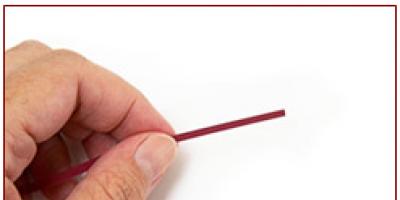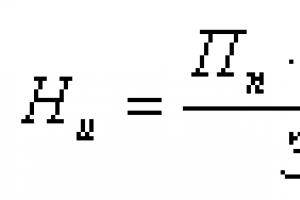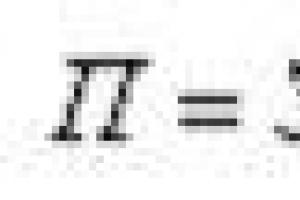At the beginning of construction, purchasing building materials in a store or market, knowledgeable people always wonder how much the sheet of slate they are planning to purchase weighs. The inhabitants shrug their shoulders in bewilderment - what difference does it make, how much it weighs, the main thing is that the material is of high quality. Of course, and this is important, but the mass of the block may be needed when calculating the rafter system during the construction of buildings and structures.
It turns out that weight is one of the important technical characteristics slate slabs, including when it comes to corrugated sheets. These and other properties different types We suggest discussing slate right now.
Characteristics of wave products
Roofs on a private house cannot be built without corrugated slate, and this is not surprising, because thanks to the large size of the blocks, the material is easy to install, quite practical to use and relatively inexpensive. The main thing is to be careful when transporting products, they can crack and break during delivery, even in disassembled form.
The weight of a wave slate sheet depends on the quality of the mass, which is prepared from asbestos, Portland cement and liquid. Asbestos fibers must be thin; this provides a reinforcement function that has a beneficial effect on the impact strength and strength of the finished fabric.
Wave slate is manufactured in the following designs:
- with a regular profile;
- with reinforced;
- with a unified profile.
The difference between slate is that it can be different sizes. The regular profile is the smallest, the reinforced profile is characterized by large slate sheets.
Now a few words about the profile, the blocks of which are found in 2 varieties:
- 40/150 mm – 8-wave, weighing 26.1 kg, 7-wave, weighing 23.2 kg;
- 54/200 mm – 5 kg with a thickness of 7.5 mm, 26 kg with a thickness of 6 mm.
What do the indicators indicated through the fraction mean? The first determines the height of the wave-like shape, while the second allows you to navigate the size of the slate wave.
Like any other building material, wave slate is subject to standardization, all this is specified in GOST, according to which the size of the wave sheet varies within the following limits:
- length reaches 1750 mm;
- the width ranges from 980 mm, if we are talking about 8 waves, to 1130 mm, if the slate consists of 7 waves.
Modern manufacturers today are allowed to produce slate in accordance with their own specifications, developed and accepted at factories by design engineers with specialized education. Therefore, do not be surprised if the indicated weight according to GOST differs greatly from the weight of the material that you see in the store.
To prevent slate from deteriorating less, it should be coated special means, this must be done in any case along the edges and seams. The composition may contain pigment; if desired, it is time to choose a transparent coating. Houses with roofs painted in brown and red shades look very stylish. The paint will improve the frost resistance characteristics and increase the service life of the roof by 2 times, or so they say experienced builders.
What is good about wave slate?
 We have already written briefly about why consumers prefer wave slate. During the application process, additional advantages are also noted:
We have already written briefly about why consumers prefer wave slate. During the application process, additional advantages are also noted:
- the sheets do not burn, so they cannot cause a fire in extreme heat;
- perfectly tolerate sudden temperature changes and harsh climatic conditions in winter;
- the blocks have good strength and strength, so they can withstand large snow accumulations and lumps;
- block the noise of rain and hail.
Many consumers believe that the high weight of wave slate is a bad indicator, but in fact its quality depends entirely on other factors:
- pay attention to the labeling and manufacturer; before purchasing, it is better to read reviews on the Internet;
- percentage presence of asbestos and fine grain, good level grinding is the key to making wave slate last longer;
- the uniform layer of asbestos placement can only be traced during the production cycle;
- compliance with technology is also a matter of responsibility and cleanliness of the manufacturer, so be guided by manufacturers who are always well-known, and be wary of newcomers to the construction market.
What is wavy slate material afraid of? Point loads, so if you hit the canvas sharply, it will most likely crack. This often happens during the installation process, so be extremely careful; it is recommended to build special bridges to move from one area to another.
Features of flat asbestos-cement slate
If you need to equip a building envelope, it is better to choose a flat sheet of slate products. You've probably seen high fences consisting of several blocks. At the production stage, flat devices can be processed by pressing, although this can be dispensed with.
One of the oldest roofing coverings is slate. Despite the fact that today the market is oversaturated with modern roofing materials, slate continues to be used to cover garages and other technical structures, not least due to its low price.
Slate characteristics
Roofing slate is asbestos cement sheets. Their main advantages, besides price, are diversity overall dimensions, allowing you to perform the roof with a minimum of waste, non-flammability, water resistance. Service life - 40 years, with good care longer.
Today's technologies make it possible to produce not only nondescript gray sheets, but also colored ones: blue, green, brown, red. The main disadvantage is the heavy weight. The technology for laying the roof is simple, but the weight of the sheets complicates the process.
There is flat and profile slate. The profile is divided by the number of waves. GOST standards describe the range of standard sizes of asbestos cement sheets:
Dimensions of flat slate: length from two and a half to three and a half meters, width 1.2 or 1.5 with a thickness of 8-20 millimeters;
Five-wave. Slate dimensions: 5.8 mm thickness, length 1.98 meters, wave pitch 26.3 cm. With such dimensions, the sheet covers only 1.6 squares, so the material is not widely used;
Six-wave. Width 112 centimeters, size 54/200 with thickness 0.6 and 0.75. The heaviest type, used primarily for covering the roofs of industrial facilities;
Semivolnovoy is popular in private development. Standard slate dimensions are 1.78 meters by 98 cm, slate thickness is 5.8 mm;
Eight waves. 5.2 and 5.8, 1.75 by 1.13 meters.
How much does a slate sheet of popular brands weigh:
Seven-wave, depending on the size and thickness, the weight of the slate sheet is 18.5-23 kilograms, 9.5-12 - a square meter;
Eight-wave – 21-35 kg, weight of 1 m2 of slate 10.5-18 square.
Price
The cost of a slate sheet depends on the brand of material, thickness, and color. The least popular color is gray, it costs less: about 400 rubles for an eight-wave sheet, from 350 for seven waves.
Colored (green, red, etc.) sheets cost from 500 rubles for both seven and eight waves.
If not so long ago slate was considered the traditional and most popular roofing material, today it is a rather rare roofing option for new buildings. Asbestos-cement slate is found infrequently and is mainly found in utility rooms, garages and other outbuildings. At new facilities it was replaced by modern, more reliable, beautiful and durable roofing materials. But old buildings are still in most cases covered with asbestos-cement slate. Such buildings have been in use for many years, and therefore there is a need to completely replace the roof.
Before making the final decision to dismantle your old slate roof, you should weigh the pros and cons. The fact is that replacing a roof is a rather expensive construction project. During its implementation, unforeseen problems may arise, which further increase the estimated cost of repairs. When should old slate be removed?
- Critical physical wear and tear. Externally, the slate sheets do not have significant damage and look quite normal, but due to natural aging, the strength of the slate decreases significantly, it becomes very fragile, in some cases the sheets are easily broken off by hand. This coating can suffer significant damage at any time during heavy rain. As a result, water gets not only into the attic, but also into living rooms. The ceilings and walls will have to be repaired interior spaces, and this greatly increases repair costs. Conclusion - you shouldn’t expect big problems, it is much more profitable to replace the old slate in a timely manner.

- A large number of mechanical damages. Doesn't mean through holes in coverings after hail - in such cases, replacement of slate is mandatory. There are situations when technological errors are made during the installation of a rafter system. The load-bearing units of the structure do not have sufficient strength and stability; when loads increase, they change their geometry and spatial position. As a result, large cracks appear on the slate sheets. If they are located on the upper ridges, there are no big problems, leaks are almost unnoticeable and do not pose a problem for attic spaces. But cracks can also be located on the lower waves, and here when it rains a lot of water flows, it will definitely fall on rafter system. As practice shows, it is useless to repair such cracks. There is only one way out - depending on the degree of damage, replace several sheets of slate or the entire roof.

- Unsatisfactory appearance.
Mosses and lichens can grow on slate roofs, which significantly worsens the appearance of the structure. There are ways mechanical cleaning coatings using electric cylindrical grinders, but experienced builders strongly do not recommend doing such work. Firstly, it is very difficult and time-consuming, and the effect is unpredictable. Secondly, there are risks of damage roofing.

Depending on the condition of the slate and the qualifications of the craftsmen, the old coating can be reused or it has to be taken to a landfill for disposal construction waste. For transportation, you should know approximately the total weight; this value is determined taking into account the mass square meter slate during disassembly.
Prices for different types of slate
How to determine the weight of 1 m2 slate during disassembly
The technical parameters of slate sheets depend on the specific type and production technology of the material. Taking into account the geometric shape of the sheet, two types are distinguished.
Wave slate
Used as roofing and facing material, has a rectangular shape. The number of waves is from five to eight, their height and thickness vary.

Wave slate is installed on slopes with a slope of at least 12°. The material is produced on automatic lines from a special mass; depending on the characteristics of the molds, it can have a different number of waves. The more waves, the higher the bending strength parameters, this allows you to reduce the thickness of the slate while maintaining the original technical data. There are 5, 6, 7 and 8 wave asbestos-cement slate sheets. Currently, five- and six-wave slates are almost never produced; most companies have switched to the production of eight-wave slates; seven-wave slates are rarely seen.
Technical characteristics of standard slate grades
Slate has regulated requirements for marking; inscriptions are applied to the outermost wave with front side. For example, the marking 1750 × 1130 × 5.2 mm, 40/150 means that the sheet has a length of 1750 mm, a width of 1130 mm and a thickness of 5.2 mm. Wave height 40 mm, distance between crests 150 mm.

Table. Covering weight depending on the type of slate.
| Slate brand | Standard weight of one sheet | Weight per square meter of coverage |
|---|---|---|
| 7-wave 1750×1130×5.2 mm, 40/150 ordinary (VO) | 18.5 kg | ≈9.5 kg |
| 7-wave 1750×1130×5.8 mm, 40/150 amplified (VU) | 23 kg | ≈11.8 kg |
| 8-wave 1750×1130×5.8 mm, 40/150 ordinary (VO) | 26 kg | ≈13.3 kg |
| 8-wave 1750×1130×6.0 mm, 54/200, unified (UV) | 30 kg | ≈15.1 kg |
| 8-wave 1750×1130×7.5 mm, 54/200, reinforced (VU) | 35 kg | ≈17.9 kg |

It would seem that the question: how much does a sheet of slate weigh may be of interest only to scientists and the most inquisitive users. However, in fact, this is quite significant information for all citizens planning to use asbestos cement sheets as a roofing material. This characteristic is important in order to accurately and, if necessary, timely strengthen the sheathing structure. Of course, all this will entail an increase in the load on the foundation and walls of the house, and it is also worth preparing for this in advance. In addition, knowing the mass of products used, you can easily get an idea of their strength, because the thicker the sheet, the more weight it has, but at the same time a greater margin of strength characteristics. So, in general, it becomes clear why knowledge about how much slate weighs is needed, which means we can move on to answering this specific question. But before deciding on this parameter, you should get a more detailed understanding of asbestos-cement sheets.
Slate features
Modern slate is durable construction material, which is very popular due to its low cost, good operational properties and a wide variety of species. The most in demand as roofing sheets are asbestos cement sheets, which can have a flat or wavy profile. Flat slate rarely used for roofing. As for wave slate, manufacturers offer three main types of such material.
Wavy slate varies in the number of waves. This material can be with 5, 6, 7 and 8 waves. Such products are manufactured in accordance with GOST 30340-2012, introduced to replace the standard 30340-95. However, many companies produce similar roofing according to the specifications of their own invention. This is not considered a violation of technology, but there may be a discrepancy in size with standard products. Therefore, before purchasing a product, it is worth asking what documentation was used to produce it. Of course, regardless of the standards used, slate has many advantages. 
Advantages of slate
Among the positive aspects of using asbestos-cement roofing material are the following:
- low level of thermal conductivity;
- fire resistance;
- excellent frost resistance;
- affordable price;
- ease of processing and ease of installation;
- long period of operation;
- high strength;
- soundproofing and noise-absorbing properties;
- wide choice of shapes, sizes and colors.
Of course, speaking about the positive aspects of using slate sheets, it is worth mentioning a number of possible disadvantages. 
Disadvantages of using slate
There are not many negative aspects of the material, however, for some users they may be decisive when choosing a roof covering, so it is worth knowing about such qualities in advance. The following characteristics can be mentioned:
- relative environmental friendliness, due to the fact that the product contains asbestos, and such raw materials can have a detrimental effect on health;
- fragility of the material, requiring care during transportation and installation;
- the formation of moss on the surface of the product after prolonged use in a humid environment;
- the unpresentable appearance of material that has not been additionally treated with paints and varnishes.
However, the listed shortcomings are largely correctable; for this, it is recommended to adhere to certain technologies when working with products, as well as timely inspection and restoration of the coating. Having learned detailed information about the products, you can move on to the question, what is the weight of a sheet of slate? 
Technical characteristics of slate
The main characteristics of slate sheets are:
- number of waves;
- material thickness;
- ridge height;
- wave step.
It is these indicators that you should pay attention to when choosing. For example, depending on the number of waves, the coating consumption changes. All characteristics required for calculation are presented in the table.
| Parameter | Characteristics | Note |
| Number of waves | 5; 6; 7; 8. | |
| Profile | 40/150; 54/200. | That is, the slate has a wave height of 40 or 54 mm, and the distance between them is 150 and 200 mm, respectively. |
| Thickness | 0.52; 0.58; 0.6; 0.75 cm. | up to 16 MPa. | This indicator is typical for standard sheets with 7 and 8 waves. Moreover, any similar products has low resistance to pinpoint impacts. |
| Density | 1.6 g/cc. | |
| Frost resistance | up to 25 cycles. | A parameter determined by the number of complete freezes and defrosts. |
| Temperature range of use | -50 – +80 degrees. | |
| Application period | 30-50 years. | After 10-15 years, the strength characteristics noticeably decrease, so the warranty period of many manufacturers is limited to 15 years. |
It is worth noting that, regardless of the number of waves or the width of the product, the consumer qualities of different brands of slate are quite similar. Of course, you should know that such indicators as the thickness of the sheet and its mechanical strength are directly related, that is, as the thickness increases, the strength qualities also increase. Weight asbestos cement sheet varies depending on the thickness of the product, as well as parameters such as the number of waves and full sizes. Weight is measured at relative humidity products within 12%. Let's consider standard weight common varieties of slate, taking into account such parameters as thickness. 
However, in many cases it is necessary to know not only the total weight of 8 wave slates or 5, 6 and so on, but also what the mass of 1 m2 of coating is. This indicator is important when calculating the load exerted by the roofing sheet on the rafter system or by the entire roof on the foundation and walls of the building. The calculations should be based on GOST, which clearly states the brand of slate, dimensions and weight of the material. So, let's consider the weight of 1 sq.m of the most popular slate sheets with standard size 175×113 cm, differing in thickness.

It is worth noting that calculating the mass of 1 m2 of roofing on slopes is not so difficult; it is enough to know the weight of 1 sheet, its area, as well as the useful area coefficient, which is calculated based on the amount of overlap. In general, it can be noted that slate is a durable roofing material with many positive qualities, among which the main ones are low cost, relatively low weight and a long operational period. To be sure to know the weight of products before purchasing them, you can always refer to the technical data sheet of the product, which every manufacturer or distributor of such material is required to provide upon the user’s request.
The weight of the slate must be taken into account when building the foundation, because the roof exerts considerable pressure on the entire structure. Slate cannot be called a lightweight material, however, due to its advantages, builders forgive it even this drawback.
Slate weight – what do you need to know?
How much does slate weigh - this question must be asked before all construction works. It is quite possible that in a particular case you will have to pay attention to lighter options, for example, metal tiles. However, none of the modern roofing materials does not have all the advantages inherent in slate, which is why it does not lose its popularity.
During construction, it is important to clearly calculate the amount of material, the specific gravity of the slate and the size of the area covered by the slate. These parameters will answer a more significant question: will the structure withstand the weight, and will the installation of slate cause excessive shrinkage? Slate is quite convenient to transport; if desired, it can be transported even by small-sized vehicles with a trailer. By the way, this is another reason to find out how much 1 sheet of slate weighs, and how many sheets can be loaded into a trailer.
Given the availability large quantity types of slate, you should understand at least the dimensions of the main ones: 8-wave, 7-wave and 6-wave slate. A certain confusion in the situation is also brought about by the fact that the sheets produced by manufacturers may differ in thickness, length and width. Naturally, the difference in dimensions cannot but affect the final weight of the product.
Parameters, according to GOST - country profiles
According to GOST 30340-95, sheets of 40/150 7-8 wave type are produced, which are most often used in country and homestead construction. 40/150 are parameters in millimeters, where 40 is the wave height, 150 is the distance between adjacent crests or wave pitch. The thickness specified in GOST varies between two values - 5.2 mm and 5.8 mm.
With a thickness of 5.8 mm:
- eight-wave profile weight – 26.1 kg;
- the weight of the seven-wave profile is 23.2 kg.
The thickness of 5.2 mm makes both profiles lighter by almost 4–4.5 kg. The actual area of the 8-wave profile is 1.97 sq.m. However, when installing a roof, 1–2 waves are always overlapped by the adjacent sheet, which reduces the usable area. Its value becomes 1.6 sq.m. for 8 waves, and 1.3 sq.m. for (with an actual area of 1.7 sq.m.)
To count correctly required amount sheets for the area that you are going to cover, you need to operate precisely with the figures of the usable area. However, we will give you a little hint - in order to cover 100 squares with eight-wave slate, you will need 64 sheets, and in the case of a 7-wave profile - 75.
Knowing these numbers, it is not at all difficult to calculate the load per 1 sq.m. We multiply 64 sheets by the weight of 26.1 kg and divide the resulting figure (1670 kg) by 100. The total weight of an 8-wave slate sheet per 1 m2 is 16.7 kg. In the case of 7-wave – 17.4 kg. The greater weight is due to the large number of overlaps. That is why for structures on light foundations it is recommended to use an 8-wave profile, since it puts less pressure on the walls and foundation. In addition to these figures, the project must also take into account the load that may arise during snowfalls or other natural phenomena.
Main characteristics of slate for 5 and 6 waves
Of course, manufacturers traditionally indicate the minimum service life of slate, but it big story in the building materials market allows us to make even more optimistic forecasts. An ordinary 8-wave slate can last for half a century, so it turns out that a 6-wave slate will last for 100? What if you paint it periodically? As they say, people don't live that long.
This type of profile is protected from widespread use only by its significant weight. If the 6 mm version of slate weighs about 26 kilograms, then a profile with a sheet thickness of 7.5 weighs all 35 kg. And this is only one sheet, what can we say about specific gravity the entire roof structure. Relatively recently, an analogue of eight-wave slate with 5 waves appeared on the market. Despite the fact that the dimensions of the slate are exactly the same as those of the 8-wave profile, the manufacturer has changed the very shape of the profile - there are flat areas between the waves.
However, this type of slate is more of an experimental novelty than an effective replacement for the usual slate sheets. In fact, builders have not yet had time to test such products. Note that all types of slate are produced as usual gray color, and in a fairly extensive color scheme. If in the first case this is the natural color of the components, then in the second the desired color is achieved in several ways.
The most effective is adding color to the mixture when making slate. This version of the product is called colored - not to be confused with painted, in which only the front side is covered with paint.
Colored slate has many advantages:
- It does not form whitish spots, so-called efflorescence.
- Slate practically does not fade over the years.
- When cutting sheets, the edges are the same color as the entire sheet.
- When scratches and abrasions occur, there are no unpainted marks.
Slate cutting and work features
When starting your work process, don’t even try to handle everything alone. You need at least 3 assistants. One will supply sheets on the ground, two on the roof (if we are talking about roofing) will receive and install. Choose calm weather for work and be sure to use insurance.
Cutting slate is much easier to do on the ground. If you are not afraid of noise and dust, use a grinder with a stone disc. In this case, you will also need an assistant who will constantly water the cut site with a watering can or hose. This will reduce the amount of dust, which does not replace the use of a respirator and goggles. Dust, mixed with water, will harden, but, nevertheless, it is still better to cover it with a layer of earth so that it does not get into the air.
If you don’t have a grinder at hand, you can use the old proven method. For this you will need a long ruler, a cutter and a table. Use a ruler cutter to cut it on the sheet in the right place. deep scratch, and then we place the slate sheet on the table, aligning its edge with the fault line. Lightly tap the sheet with a hammer and then press gently. The unnecessary piece of material will break off, and you will only have to smooth out the bumps on the edge with a file.








